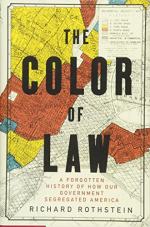
|
| Name: _________________________ | Period: ___________________ |
This test consists of 15 multiple choice questions and 5 short answer questions.
Multiple Choice Questions
1. What kind of developments was New Orleans Mayor DeLesseps Morrison told that the FHA wanted?
(a) Houses for whites, slums for blacks.
(b) Segregated.
(c) Separate-but-equal.
(d) Integrated.
2. When does Rothstein say a federal appeal court finally determined that racially restrictive covenants were unconstitutional?
(a) 2004.
(b) 1996.
(c) 1972.
(d) 1988.
3. How recently has the U.S. Supreme Court said that de facto segregation is beyond its jurisdiction?
(a) 2007.
(b) 1986.
(c) 1992.
(d) 1968.
4. Where does Rothstein say Langston Hughes grew up?
(a) In a segregated neighborhood.
(b) In a slum.
(c) In an integrating neighborhood.
(d) In a comfortable suburb.
5. What is the most extreme measure blockbusters took to inspire racial fears and get whites to sell their homes?
(a) Advertise home for sale in black newspapers.
(b) Set up burglaries.
(c) Hire black women to push baby carriages through a neighborhood.
(d) Hire black men to canvas door-to-door, looking for houses for sale.
6. What effect does Rothstein say the federal government had on segregation in housing?
(a) They realigned it along economic class lines.
(b) They restored it.
(c) They exacerbated it.
(d) They remedied it.
7. What role did Richmond police play in maintaining segregation?
(a) Harassing blacks with petty arrests.
(b) Vandalizing model homes in integrated developments.
(c) Murdering unarmed black people to keep them out of the city.
(d) Allowing racist mobs to commit crimes with impunity.
8. What does Rothstein say the Supreme Court decided about housing and discrimination in 1883?
(a) Housing was fully covered by anti-discrimination laws.
(b) Housing was not related to slavery.
(c) Housing was only accountable to the market.
(d) Housing was a human right.
9. What does Rothstein say was the main driver of de jure segregation?
(a) Mass incarceration.
(b) Wage suppression and wage theft.
(c) Lynching and other forms of terrorism.
(d) Public housing.
10. What euphemism does Rothstein say appraisers used to describe integrated neighborhoods?
(a) Adverse influences.
(b) Inharmonious neighborhoods.
(c) Heterogeneous neighborhoods.
(d) Incompatible ownership occupancy.
11. Who does Rothstein say was the only one who had standing to enforce a racially restrictive covenant?
(a) The homeowners’ association.
(b) The community.
(c) The local government.
(d) The previous owner.
12. When did the PWA end?
(a) 1957.
(b) 1917.
(c) 1937.
(d) 1982.
13. Which case made housing discrimination illegal as national policy?
(a) Brown.
(b) Jones.
(c) Buchanan.
(d) Shelley.
14. How does Rothstein explain how places like Ferguson, MO got to be so racially homogenous?
(a) Housing policies trapped black families in overcrowded slums.
(b) Exclusionary zoning kept black families from integrating with whites in middle-class neighborhoods.
(c) Wages were so low that African-American families could not afford to move into those neighborhoods.
(d) Racial violence kept black families from moving out of their slums.
15. What did the Buchanan decision outlaw?
(a) Inclusionary zoning ordinances.
(b) Fair share policies.
(c) Racially restrictive covenants.
(d) Racial zoning ordinances.
Short Answer Questions
1. When would a black family acquire equity in the house it bought, under the kinds of sales blockbusters typically used?
2. Why was Gerald Cohn of San Francisco investigated by the FBI?
3. What kind of language did federal documents use to disguise their racial intent?
4. What does Beryl Satter say was one of the consequences of buying from blockbusters?
5. What turmoil does Rothstein say led him to consider writing this book?
|
This section contains 558 words (approx. 2 pages at 300 words per page) |

|




